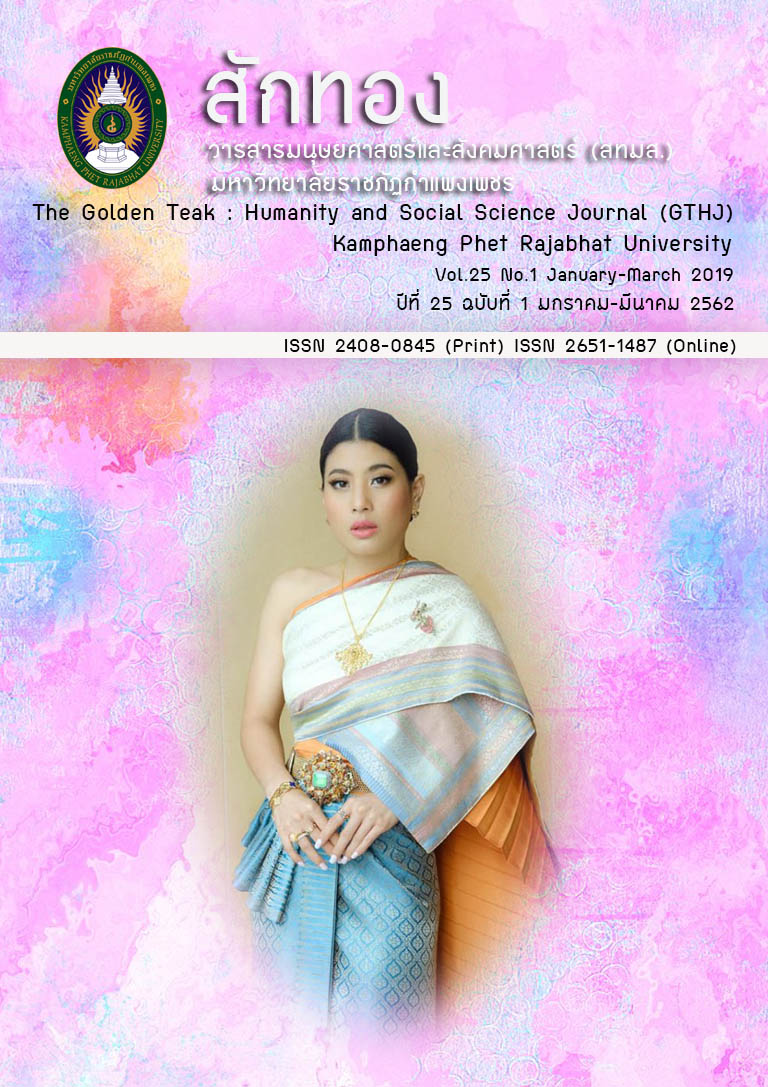Spatial drought evaluation using MODIS Normalized Difference Vegetation Index and Land Surface Temperature data in the east side of Ping river Kamphaeng Phet province
Main Article Content
Abstract
This study aims to evaluate spatial drought using the Normalized Difference Vegetation Index (NDVI) and Land Surface Temperature (LST) based on MODIS data, in the east side of Ping River, Kamphaeng Phet province. The process that include, collected 16-day composite of NDVI and 8-day composite of LST data from MOD13A1 and MOD11A2 product during dry season in November 2015 to April 2016. Then calculated the Normalized Vegetation Supply Water Index (NVSWI) to assess five levels of drought class, include severe drought, moderate drought, slight drought, normal drought, and wet area. Moreover, the study also analyzes level of drought classes with environmental properties. The results show that, when considered the NDVI graphs at that time, the NDVI values tend to decrease continuously from November to April, while the graph of LST is higher. The average of NDVI and LST values equal 0.481 and 34.2 °C, respectively. November was the month with the highest average of NDVI and April provide the highest average of LST. For drought Index analysis found that the severe drought area cover 0.86%, moderate drought 47.19%, slight drought 48.59%, normal or no drought 3.37%, and not appear the wet area class. Analysis of drought levels and environmental properties found that mostly of moderate to severe drought classes area that appear in rice field (57.14%) and sugarcane (19.27%), and the soil type is sandy loam (45.19%). There are 308 villages in these drought classes (54.23%). This result that corresponds to drought conditions in the actual area. Therefore, it can be concluded that vegetation index and surface temperature can be used to visualize spatial droughts, especially agricultural drought.
Article Details
บทความที่ได้รับการตีพิมพ์เป็นลิขสิทธิ์ของวารสาร สักทอง : วารสารมนุษยศาสตร์และสังคมศาสตร์ สถาบันวิจัยและพัฒนา มหาวิทยาลับราชภัฏกำแพงเพชร
ข้อคิดเห็นใดๆ ที่ปรากฎในวารสารเป็นวรรณกรรมของผู้เขียนโดยเฉพาะ ซึ่งมหาวิทยาลัยราชภัฏกำแพงเพชรและบรรณาธิการไม่จำเป็นต้องเห็นด้วย
References
Anyamba, A., Tucker, C. J., & Eastman, J. R. (2001). NDVI anomaly patterns over Africa during the 1997/98 ENSO warm event. International Journal of Remote Sensing, 22, 1847-1859.
Bayarjargal, Y., Adyasuren, T., & Munkhtuya, S. (2000). Drought and vegetation monitoring in the arid and semi-arid regions of the Mongolia using remote sensing and ground data. Proceedings of 21st Asian Conference on Remote Sensing, Taipei. Taiwan, 1, 372-377.
Bayarjargal, Y., et al. (2006). A comparative study of NOAA–AVHRR derived drought indices using change vector analysis. Remote Sensing of Environment, 105, 9-22.
Bhuiyan, C. (2004). Various drought indices for monitoring drought condition in Aravalli terrain of India. Proceedings of the XXth ISPRS Conference. Int. Soc. Photogramm. Remote Sens., Istanbul. Working Group, VII/5, 1-6.
Bhuiyan, C., Singh, R. P., & Kogan, F. N. (2006). Monitoring drought dynamics in the Aravalli region (India) using different indices based on ground and remote sensing data. International Journal of Applied Earth Observation and Geoinformation, 8, 289-302.
Carlson, T. N., Perry, E. M., & Schmugge, T. J. (1990). Remote sensing estimation of soil moisture availability and fractional vegetation cover for agricultural fields. Agricultural and Forest Meteorology, 52, 45-69.
Gao, B. (1996), NDWI-A normalized difference water index for remote sensing of vegetation liquid water from space. Remote Sensing of Environment, 58, 257-266.
Heim, R. R. (2002). A review of twentieth-century drought indices used in the United States. Bulletin of the American Meteorological Society, 84, 1149-1165.
Jie Zhang, Qiaozhen Mu, & Jianxi Huang. (2016). Assessing the remotely sensed Drought Severity Index for agriculturaldrought monitoring and impact analysis in North China. Ecological Indicators, 63, 296-309.
Kogan, F. N. (1990). Remote sensing of weather impacts on vegetation in nonhomogeneous areas. International Journal of Remote Sensing, 11, 1405-1419.
_______. (1995). Application of vegetation index and brightness temperature for drought detection. Advances in Space Research, 11, 91-100.
_______. (1997). Global drought watch from space. Bulletin of the American Meteorological Society, 78, 621-636.
Lambin, E. F., & Ehrlich, D. (1996). The surface temperature–vegetation index space for land cover and land-cover change analysis. International Journal of Remote Sensing, 17, 463-478.
Liu, W. T., & Negron-Juarez, R. I. (2001). ENSO drought onset prediction in northeast Brazil using NDVI. International Journal of Remote Sensing, 22, 3483-3501.
NASA. (2017). MODIS. [Online]. Available : https://modis.gsfc.nasa.gov/. [2017, January 6].
Rouse, J. W., et al. (1974). Monitoring the Vernal Advancement and Retrogradation (Greenwave Effect) of Natural Vegetation. NASA/GSFC : Greenbelt, MD, USA.
Ruthamnong, S. (2015). Remote Sensing. Kamphaeng Phet : Kamphaeng Phet Rajabhat University.
_______. (2017). Geomatics for Analysis of Flood and Drought Risk Areas in Khlong Suan Mak Basin, Kamphaeng Phet Province. The Golden Teak : Humanity and Social Science, 23(2), 86-103.
Sawaid A., et al. (2014). Characterization of Drought Development through Remote Sensing : A Case Study in Central Yunnan, China. Remote Sensing of Environment, 6, 4998-5018.
Son, N. T., et al. (2012). Monitoring agricultural drought in the Lower Mekong Basin using MODIS NDVI and land surface temperature data. International Journal of Applied Earth Observation and Geo-information, 18, 417-427.
Tucker, C. J. (1979). Red and photographic infrared linear combinations for monitoring vegetation. Remote Sensing of Environment, 8, 127-150.
Tucker, C. J., & Choudhury, B. J. (1987). Satellite remote sensing of drought conditions. Remote Sensing of Environment, 23, 243-251.
WU Men-xin, & LU Hou-quan. (2016). A modified vegetation water supply index (MVWSI) and its application in drought monitoring over Sichuan and Chongqing, China. Journal of Integrative Agriculture, 15(9), 2132-2141.
Yingxin Gu, et al. (2007). A five-year analysis of MODIS NDVI and NDWI for grassland drought assessment over the central Great Plains of the United States. Geophysical Research Letters, 34, 1-6.

